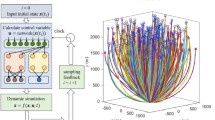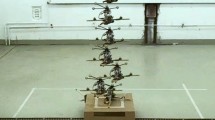Abstract
This paper focuses on improving the autonomy and efficiency of fuel-optimal powered landing guidance for reusable rockets considering aerodynamic forces. Deep-learning-based methods are developed to enable online and autonomous operation ability and to avoid the convergence problem encountered by classic indirect and direct optimal control methods. Considering the complex uncertainties of the preceding entry flight and potential unsettling hand-over conditions, a classification network is designed to classify the initial states of landing flights into different categories that correspond to bang–bang or non-bang–bang/singular thrust profiles. Thus, the subsequent online regression network can perform well for a large initial state distribution, and the algorithm adjusts to extensive landing situations. The combined application of classification and regression networks is one of the main contributions of the paper. The offline trained state-action regression networks generate guidance commands according to the real-time rocket state, obtaining a near-optimal landing trajectory. In addition, an online parallel trajectory simulation strategy is proposed to verify the trajectory quality, and an alternative trajectory optimization procedure is embedded into the proposed network-based framework to enhance the safety and accuracy of the guidance algorithm, representing another major contribution. Numerical experiments are presented to evaluate the effectiveness and accuracy of the proposed algorithm.




















Similar content being viewed by others
References
https://www.blueorigin.com/news/new-shepard-ns-18-mission-updates
Song Z, Wang C, Theil S, Seelbinder D, Sagliano M et al (2020) Survey of autonomous guidance methods for powered planetary landing. Front Inf Technol Electr Eng 21(5):652–674
Malyuta D, Yu Y, Elango P, Açıkmeşe B (2021) Advances in trajectory optimization for space vehicle control. Annu Rev Control 52:282–315
Betts J (1998) Survey of numerical methods for trajectory optimization. J Guid Control Dyn 21(2):193–207
Garg D, Patterson M, Hager W et al (2010) A unified framework for the numerical solution of optimal control problems using pseudospectral methods. Automatica 46(11):1843–1851
Malyuta D, Reynolds T, Szmuk M, et al. (2019) Discretization performance and accuracy analysis for the rocket powered descent guidance problem. AIAA Scitech 2019 Forum. AIAA-2019:0925
Liu X, Lu P, Pan B (2017) Survey of convex optimization for aerospace applications. Astrodynamics 1(1):23–40
Sagliano M (2018) Pseudospectral convex optimization for powered descent and landing. J Guid Control Dyn 41(2):320–334
Açıkmeşe B, Ploen S (2007) Convex programming approach to powered descent guidance for mars landing. J Guid Control Dyn 30(5):1353–1366
Liu X (2019) Fuel-optimal rocket landing with aerodynamic controls. J Guid Control Dyn 42(1):65–77
Wang J, Li H, Chen H (2020) An iterative convex programming method for rocket landing trajectory optimization. J Astronaut Sci 67(4):1553–1574
Li Y, Chen W, Zhou H et al (2020) Conjugate gradient method with pseudospectral collocation scheme for optimal rocket landing guidance. Aerosp Sci Technol 104:105999
Sagliano M (2019) Generalized hp pseudospectral-convex programming for powered descent and landing. J Guid Control Dyn 42(7):1562–1570
Sagliano M, Heidecker A, Hernández JM, et al. (2021) Onboard guidance for reusable rockets: aerodynamic descent and powered landing. AIAA Scitech 2021 Forum. AIAA-2021:0862
Sagliano M, Mooij E (2021) Optimal drag-energy entry guidance via pseudospectral convex optimization. Aerosp Sci Technol 117:106946
Szmuk M, Reynolds T, Açıkmeşe B, et al. (2019) Successive convexification for 6-dof powered descent guidance with compound state-triggered constraints. AIAA Scitech 2019 Forum. AIAA-2019:0926
Reynolds T, Malyuta D, Mesbahi M, et al. A real-time algorithm for non-convex powered descent guidance. AIAA Scitech 2020 Forum. AIAA-2020:0844.
Reynolds T, Malyuta D, Mesbahi M, et al. (2021) Funnel synthesis for the 6-DOF powered descent guidance problem. AIAA Scitech 2021 Forum. AIAA-2021:0504
Izzo D, Märtens M, Pan B (2019) A survey on artificial intelligence trends in spacecraft guidance dynamics and control. Astrodynamics 3(4):287–299
Chai R, Tsourdos A, Savvaris A et al (2021) Review of advanced guidance and control algorithms for space/aerospace vehicles. Prog Aerosp Sci 122:100696
LeCun Y, Bengio Y, Hinton G (2015) Deep learning. Nature 521(7553):436–444
Ding Y, Hua L, Li S (2022) Research on computer vision enhancement in intelligent robot based on machine learning and deep learning. Neural Comput Appl 34(4):2623–2635
Pescador F, Mohanty SP (2021) Machine learning for smart electronic systems. IEEE Trans Consum Electron 67(4):224–225
Izzo D, Sprague C, Tailor D (2019) Machine learning and evolutionary techniques in interplanetary trajectory design. Modeling and optimization in space engineering. Springer, Cham
Bai J, Lian S, Liu Z et al (2018) Deep learning based robot for automatically picking up garbage on the grass. IEEE Trans Consum Electr 64(3):382–389
Dong R, Chang Q, Ikuno S (2021) A deep learning framework for realistic robot motion generation. Neural Comput Appl. https://doi.org/10.1007/s00521-021-06192-3
Shi Y, Wang Z (2020) Onboard generation of optimal trajectories for hypersonic vehicles using deep learning. J Spacecr Rocket 58(2):400–414
Federici L, Benedikter B, Zavoli A (2021) Deep learning techniques for autonomous spacecraft guidance during proximity operations. J Spacecr Rocket 58(6):1774–1785
Zavoli A, Federici L (2021) reinforcement learning for robust trajectory design of interplanetary missions. J Guid Control Dyn 44(8):1440–1453
Sánchez-Sánchez C, Izzo D (2018) Real-time optimal control via deep neural networks: study on landing problems. J Guid Control Dyn 41(5):1122–1135
Izzo D, Öztürk E (2021) Real-time guidance for low-thrust transfers using deep neural networks. J Guid Control Dyn 44(2):315–327
Cheng L, Wang Z, Jiang F et al (2019) Fast generation of optimal asteroid landing trajectories using deep neural networks. IEEE Trans Aerosp Electron Syst 56(4):2642–2655
Cheng L, Jiang F, Wang Z et al (2020) Multiconstrained real-time entry guidance using deep neural networks. IEEE Trans Aerosp Electron Syst 57(1):325–340
You S, Wan C, Dai R et al (2022) Onboard fuel-optimal guidance for human-Mars entry, powered-descent, and landing mission based on feature learning. Acta Astronaut 195(6):129–144
Furfaro R, Bloise I, Orlandelli M et al (2018) Deep learning for autonomous lunar landing. 2018 AAS/AIAA Astrodynamics Specialist Conference. Univelt 167:3285–3306
Cheng L, Wang Z, Song Y et al (2020) Real-time optimal control for irregular asteroid landings using deep neural networks. Acta Astronaut 170:66–79
Eren U, Dueri D, Açıkmeşe B (2015) Constrained reachability and controllability sets for planetary precision landing via convex optimization. J Guid Control Dyn 38(11):2067–2083
Khashei M, Hamadani AZ, Bijari M (2012) A novel hybrid classification model of artificial neural networks and multiple linear regression models. Expert Syst Appl 39(3):2606–2620
Meditch J (1964) On the problem of optimal thrust programming for a lunar soft landing. IEEE Trans Autom Control 9(4):477–484
Leitmann G (1959) On a class of variational problems in rocket flight. J Aerosp Sci 26(9):586–591
Lu P (2018) Propellant-optimal powered descent guidance. J Guid Control Dyn 41(4):813–826
Wang J, Cui N, Wei C (2019) Optimal rocket landing guidance using convex optimization and model predictive control. J Guid Control Dyn 42(5):1078–1092
Leparoux C, Hérissé B, Jean F (2022) Structure of optimal control for planetary landing with control and state constraints. ar**v preprint ar**v:2204.06794
Jarrett K, Kavukcuoglu K, Ranzato M, et al. (2009) What is the best multi-stage architecture for object recognition. In: 2009 IEEE 12th international conference on computer vision. IEEE, 2009: 2146–2153
LeCun Y, Bottou L, Orr G et al (2012) Efficient backprop, Neural networks: tricks of the trade. Springer, Berlin
Glorot X, Bengio Y (2010) Understanding the difficulty of training deep feedforward neural networks. Proceedings of the thirteenth international conference on artificial intelligence and statistics. JMLR Workshop and Conference Proceedings, pp 249–256
Simos TE, Tsitouras C (2021) Efficiently inaccurate approximation of hyperbolic tangent used as transfer function in artificial neural networks. Neural Comput Appl 33(16):10227–10233
Patterson M, Rao A (2014) GPOPS-II: a MATLAB software for solving multiple-phase optimal control problems using hp-adaptive Gaussian quadrature collocation methods and sparse nonlinear programming. ACM Trans Math Soft TOMS 41(1):1–37
Ross IM, Karpenko M (2012) A review of pseudospectral optimal control: From theory to flight. Annu Rev Control 36(2):182–197
Huneker L, Sagliano M, Arslantas Y (2015) SPARTAN: an improved global pseudospectral algorithm for high-fidelity entry-descent-landing guidance analysis. In: 30th International Symposium on Space Technology and Science, Kobe, Japan
Liu X, Zhang X, Peng W, et al (2022) A novel meta-learning initialization method for physics-informed neural networks. Neural Comput Appl. pp 1–24
Acknowledgements
This work was supported by the Fundamental Research Funds for the Central Universities (191gpy288) and National Nature Science Foundation of China (61873306).
Author information
Authors and Affiliations
Corresponding author
Ethics declarations
Conflict of interest
The authors declare no conflict of interest.
Data availability
Data are available on request from the authors.
Additional information
Publisher's Note
Springer Nature remains neutral with regard to jurisdictional claims in published maps and institutional affiliations.
Rights and permissions
Springer Nature or its licensor (e.g. a society or other partner) holds exclusive rights to this article under a publishing agreement with the author(s) or other rightsholder(s); author self-archiving of the accepted manuscript version of this article is solely governed by the terms of such publishing agreement and applicable law.
About this article
Cite this article
Wang, J., Ma, H., Li, H. et al. Real-time guidance for powered landing of reusable rockets via deep learning. Neural Comput & Applic 35, 6383–6404 (2023). https://doi.org/10.1007/s00521-022-08024-4
Received:
Accepted:
Published:
Issue Date:
DOI: https://doi.org/10.1007/s00521-022-08024-4




